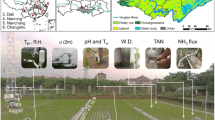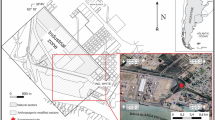Abstract
Ammonia (NH3) emissions from manure constitute a significant loss of fixed nitrogen (N) from agricultural systems and contribute to air pollution and ecosystem degradation. Accurate models of such NH3 emissions will improve our understanding of the factors that control the emissions and allow appropriate mitigation actions to be identified and quantified. Although the importance of manure pH on ammonia emission has been recognized for decades, the physical and chemical interactions that control pH are not fully understood. Here we present a novel mathematical model that includes the dynamic and crucial pH changes in the surface of stored slurry or slurry applied in the field. In the model, slurry pH is calculated by simultaneously determining: (1) speciation of the acid–base reactions, (2) diffusion of each buffer species, and (3) emission of NH3 and CO2. New features of the model include a reduced variable that combines time and location and an analytical approach to solving the resulting system of equations using Mathematica. To evaluate the model, we made measurements of pH at a resolution of 0.1 mm in the top 30 mm of an ammonium bicarbonate solution. These measurements show the creation of a large pH gradient (>1 pH unit in <30 mm after 20 h) and its change over time due to simultaneous NH3 and CO2 emission from aqueous solutions. The model was able to accurately predict the development of pH gradients over time, suggesting that our understanding of the factors controlling pH is correct. New developments presented in the model should be useful for future work on understanding and predicting NH3 emission from manure.







Similar content being viewed by others
Abbreviations
- D X :
-
Diffusion coefficient of chemical species X in water (cm2 s−1)
- D X,Air :
-
Diffusion coefficient of chemical species X in air (cm2 s−1)
- F X :
-
Constant determining how quickly the species X is transported from water to air through the water–air surface (mol L−1 cm s−1/2). The cumulative mass transported to the air through area A over time t is given by the expression \(A\sqrt t F_{x}\)
- \(H_{X} = \frac{{[X]_{0} }}{{[X]_{0,Air} }}\) :
-
Henry´s law constant for the chemical species X (dimensionless)
- K X :
-
Equilibrium constant for the chemical reaction of the species X
- z :
-
Depth in solution or height in the air, always positive (cm)
- t :
-
Time since stirring, always positive (s)
- \(w = \frac{z}{\sqrt t }\) :
-
Reduced variable, always positive (cm s−1/2)
- [X]:
-
Concentration of chemical species X in water (mol L−1)
- [X] Air :
-
Concentration of chemical species X in air (mol L−1)
- [X]0 :
-
Concentration of chemical species X in water at the water–air surface (mol L−1)
- [X]∞ :
-
Concentration of chemical species X in water at infinite depth (bulk value) (mol L−1)
- [X]0,Air :
-
Concentration of chemical species X in air at the water–air surface (mol L−1)
- [X]∞,Air :
-
Concentration of chemical species X in air at infinite height (bulk value) (mol L−1)
- TAN:
-
Total Ammonia Nitrogen: [TAN] = [NH3] + [NH4 +] (mol L−1)
- TIC:
-
Total Inorganic Carbon: [TIC] = [CO2] + [HCO3 −] + [CO −23 ] (mol L−1)
- α x :
-
Ionization fraction for TAN or TIC: [X] = α x [TAN] or [X] = α x [TIC]. It is a polynomial fraction which depends only on [H3O+] and has values between 0 and 1 (dimensionless)
References
Beusen AHW, Bouwman AF, Heuberger PSC, Van Drecht G, Van Der Hoek KW (2008) Bottom-up uncertainty estimates of global ammonia emissions from global agricultural production systems. Atmos Environ 42:6067–6077
Beutier D, Renon H (1978) Representation of NH3-H2S-H2O, NH3-CO2-H2O, and NH3-SO2-H2O vapor-liquid equilibria. Ind Eng Chem Process 17:220–230
Blanes-Vidal V, Sommer SG, Nadimi ES (2009) Modeling surface pH and emissions of hydrogen sulphide, ammonia, acetic acid and carbon dioxide from a swine waste lagoon. Biosyst Eng 104:510–521
Broboff S, Phillips RJ, Shekarriz A (1998) Nuclear magnetic resonance measurement of ammonia diffusion in dense solid–liquid slurries. Pacific Northwest National Laboratory Richland, Washington. PNNL-11678 (REV.1 UC-2030. pp 25
Buijsman E, Maas JF, Asman WAH (1987) Anthropogenic NH3 emissions in Europe. Atmos Environ 21:1009–1022
Bussink DW, Huijsmans JFM, Ketelaars JJMH (1994) Ammonia volatilization from nitric-acid-treated cattle slurry surface applied to grassland. Neth J Agric Sci 42:293–309
Canh TT, Sutton AL, Aarnink AJA, Verstegen MWA, Schrama JW, Bakker GCM (1998) Dietary carbohydrates alter the fecal composition and pH and the ammonia emission from slurry of growing pigs. J Anim Sci 76:1887–1895
Chaoui H, Montes F, Rotz CA, Richard TL (2009) Volatile ammonia fraction and flux from thin layers of buffered ammonium solution and dairy cattle manure. Trans ASABE 52:1695–1706
Davidson EA (2009) The contribution of manure and fertilizer nitrogen to atmospheric nitrous oxide since 1860. Nat Geosci 2:659–662
EU (2001) Directive 2001/81/EC of the European Parliament and of the Council. On national emission ceilings for certain atmospheric pollutants. Official Journal of the European Communities. L 309/22 to L 309/30
Frank MJW, Kuipers JAM, van Swaaij WPM (1996) Diffusion coefficients and viscosities of CO2 + H2O, CO2 + CH3OH, NH3 + H2O, and NH3 + CH3OH liquid mixtures. J Chem Eng Data 41:297–302
Galloway J, Aber J, Erisman J, Seitzinger S, Howarth R, Cowling E, Cosby B (2003) The nitrogen cascade. Bioscience 53:341–356
Génermont S, Cellier P (1997) A mechanistic model for estimating ammonia volatilisation from slurry applied to bare soil. Agric For Meteorol 88:145–167
Hafner SD, Bisogni JJ (2009) Modeling of ammonia speciation in anaerobic digesters. Water Res 43:4105–4114
Hafner SH, Montes F, Rotz CA (2013) The role of carbon dioxide in emission of ammonia from manure. Atmos Environ 66:63–71
Hutchings NJ, Sommer SG, Andersen JM, Asman WAH (2001) A detailed ammonia emission inventory for Denmark. Atmos Environ 35:1959–1968
Kai P, Pedersen P, Jensen JE, Hansen MN, Sommer SG (2008) A whole-farm assessment of the efficacy of slurry acidification in reducing ammonia emissions. Eur J Agron 28:148–154
Kerstin J, Sokolov M, Wakeham WA (1978) Viscosity of liquid water in the range -8 °C to 150 °C. J Phys Chem Ref Data 7:941–948
Markfoged M (2013) Microbial control of gas-exchange at air–manure interfaces. PhD thesis, University of Aarhus, Aarhus
Marrero TR, Mason EA (1972) Gaseous diffusion coefficient. J Phys Chem Ref Data 1:1–117
McLaughlin MR, Brooks JP, Adeli A (2012) Temporal flux and spatial dynamics of nutrients, fecal indicators, and zoonotic pathogens in anaerobic swine manure lagoon water. Water Res 46:4949–4960
Ni J (1999) Mechanistic model of ammonia release from liquid manure: a review. J Agric Eng Res 72:1–17
Revsbech NP, Jorgensen BB (1986) Microelectrodes—their use in microbial ecology. Adv Microbiol Ecol 9:293–352
Sommer SG, Husted S (1995) A simple model of pH in slurry. J Agric Sci 124:447–453
Sommer SG, Sherlock RR (1996) pH and buffer component dynamics in the surface layers of animal slurries. J Agric Sci 127:109–116
Spiller LL (1989) Determination of ammonia/air diffusion coefficient using nafion lined tube. Anal Lett 22:2561–2573
Sutton MA, Oenema O, Erisman JW, Leip A, van Grinsven H, Winiwarter W (2011) Too much of a good thing. Nature 472:159–161
United Nations (2004) Handbook for the 1979 convention of long-range transboundary air pollution and its protocols. UNECE Publication Unit, Geneva, Switzerland. http://www.unece.org/env/lrtap/BIBLE.E.pdf
Van der Molen J, Beljaars ACM, Chardon WJ, Jury WA, Van Faassen HG (1990) Ammonia volatilization from arable land after application of cattle slurry. 2. Derivation of a transfer model. Neth J Agric Sci 38:239–254
Zeebe RE (2011) On the molecular diffusion coefficients of dissolved CO2, HCO3 −, and CO3 2− and their dependence on isotopic mass. Geochim Cosmochim Acta 75:2483–2498
Zimmo OR, van der Steen NP, Gijzen HJ (2003) Comparison of ammonia volatilisation rates in algae and duckweed-based waste stabilisation ponds treating domestic wastewater. Water Res 37:4587–4594
Acknowledgments
We thank Grønt udviklings- og demonstration program for the financial support (Gylle—IT), Ministeriet for Fødevarer, Landbrug og Fiskeri - NaturErhvervstyrelsen. We thank Lars B Pedersen, Preben Sørensen, and and Niels Peter Revsbech (Aarhus University, Bioscence - European Research Council, Grant No. 267233) for constructing the hock formed temperature sensors and pH electrodes, Steen Bennike Mortensen (NovoZymes) for providing us with the carbonic anhydrase and Henrik Midtiby for valuable comments to the model development.
Author information
Authors and Affiliations
Corresponding author
Electronic supplementary material
Below is the link to the electronic supplementary material.
Rights and permissions
About this article
Cite this article
Petersen, V., Markfoged, R., Hafner, S.D. et al. A new slurry pH model accounting for effects of ammonia and carbon dioxide volatilization on solution speciation. Nutr Cycl Agroecosyst 100, 189–204 (2014). https://doi.org/10.1007/s10705-014-9637-6
Received:
Accepted:
Published:
Issue Date:
DOI: https://doi.org/10.1007/s10705-014-9637-6




